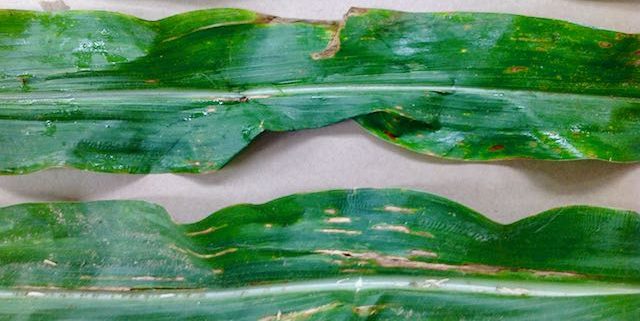Bacterial Leaf Streak of Corn Confirmed for the First time in Wisconsin
Damon L. Smith, Extension Field Crops Pathologist, University of Wisconsin-Madison
Carol Groves, Associate Researcher, University of Wisconsin-Madison
Brian Hudelson, Plant Disease Diagnostician, University of Wisconsin-Madison
Sue Lueloff, Assistant Plant Disease Diagnostician, University of Wisconsin-Madison

Figure 1. Symptoms of bacterial leaf streak on corn.
The 2018 corn production season in Wisconsin has been challenging to say the least. We had what looked to be some of the best corn production we ever had, and then the diseases started to move in. We have observed numerous foliar disease issues and have spent a lot of time trying to understand the tar spot epidemic in Wisconsin and surrounding states.
To add insult to injury, we have now confirmed bacterial leaf streak (BLS) of corn. You may remember that we have been on the lookout for this disease over the past several seasons, but have not confirmed it officially in the state until now. A corn sample was received in our Plant Disease Diagnostic Clinic this season from Pierce County with symptoms consistent with those for BLS (Fig. 1). The sample was confirmed positive in our clinic through multiple tests, including bacterial streaming and PCR. Subsequently, the sample has been confirmed positive by multiple laboratories, including the CPHST-Beltsville Laboratory.
Bacterial leaf streak (BLS) of corn was reported for the first time on corn in the U.S. in 2016, but was likely present in Nebraska since 2014. The first report was in Nebraska with subsequent reports coming in from other states in the U.S. corn belt. Other states where the disease has been confirmed include Iowa, Illinois, Colorado, Kansas, Minnesota, Oklahoma, South Dakota, Texas, and now Wisconsin.
What causes bacterial leaf streak and what are the symptoms?
Bacterial leaf streak is caused by a bacterium named Xanthomonas vasicola pv. vasculorum. It causes wavy narrow leaf lesions with wavy edges that are often brown in color. Lesions can appear translucent and have halos when backlit. Symptoms on corn have been observed as early as V7, starting in the lower canopy and moving up the canopy if weather conditions are favorable (wet weather, with hot temperatures). Little is known about the disease cycle, but researcher believe it can overwinter on corn residue. The bacterium is presumed to be spread by irrigation, splashing rain, or wind-driven rain. No injury is needed for the bacterium to enter the plant. It is unknown if the bacterium can be spread on, or in, seed and if there are alternative weed hosts.
Does bacterial leaf streak cause yield loss?
Little is actually known about the disease on corn in the U.S. Most researchers believe that yield loss is minimal if the disease moves in late in the season. If the disease moves in earlier and causes extensive leaf blighting during grain fill, then yield losses could be more substantial. Little is known about the effect of BLS on grain quality.
How do I manage bacterial leaf streak of corn?
Some corn hybrids appear to have better resistance to BLS than others. Work with your seed dealer to find a hybrid that is rated as resistant and fits your environment. Hybrid resistance will be key to manage this disease. BLS is caused by a bacterium, thus, fungicides are not effective in controlling this disease. Withholding irrigation has also been shown to not be effective as the disease can occur in drylands and irrigated fields. Managing corn residue through rotation may be helpful. Tillage and burying residue might also be an option, but managing soil erosion should be placed as a higher priority.
Other Resources about bacterial leaf streak
- You can click here to read the USDA APHIS Statement on Xanthomonas vasicola pv. vasculorum.
- To learn more about the disease and to watch a video by Dr. Tamra Jackson-Ziems at the University of Nebraska CLICK HERE.
- To learn how BLS is diagnosed in the lab, CLICK HERE to watch a video from Iowa State University.
- CLICK HERE to download a fact sheet on BLS of corn, by a team of U.S. plant pathologists.
How do I get a diagnosis if I suspect bacterial leaf streak?
If you suspect that you have BLS in your corn crop in Wisconsin, leaf samples of corn plants can be sent in a sealed plastic bag with NO added moisture to the University of Wisconsin Plant Disease Diagnostic Clinic (PDDC). Information about the clinic and how to send samples can be found by CLICKING HERE.





